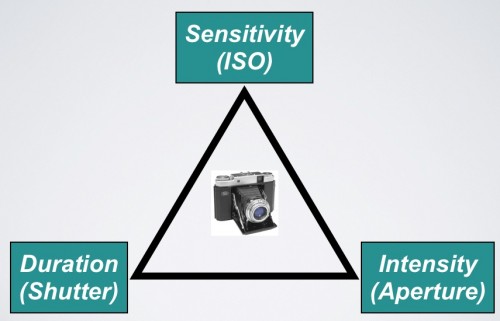You know the exposure triangle, yes?
They work together. All three of these variable affect exposure (“how bright it is”).
- For a brighter picture, you go to a higher ISO, or a lower “f-number”, or a slower shutter speed.
- For a darker picture, the opposite.
And to make things easy, we have “main numbers” for each of the three variables.
- Each of these main numbers doubles, or halves, the light.
- We call a doubling, or halving, of the light “one stop”.
- So the main numbers are one stop apart.
Main numbers are like this:
- Shutter: …1/8 sec, 1/15, 1/30, 1/60, 1/125, 1/250, 1/500, 1/1000, 1/2000 …
- ISO: …ISO100, 200, 400, 800, 1600, 3200…
- Aperture: … f/1.4, 2.0, 2.8, 4.0, 5.6, 8, 11, 16, 22 …
Moving ISO “to the right” in the table above makes things brighter; that’s the definition of ISO sensitivity. Moving aperture and shutter “to the right”, on the other hand, makes things darker. (Why? A faster speed means a quicker click, which means less light gets in. A larger f-number gives us a smaller opening in the lens; that too results in less light).
And these can cancel each other out! So if you make one change that would darken the image by a stop, and at the same time make another change that would brighten the image by a stop, you will end up with the same brightness in the resulting picture.
E.g. moving from 400 ISO to 800 ISO (“brighter”) and at the same time going from 1/60 to 1/125 second (“darker”) would result in the same brightness.
Your camera probably adjusts things in steps of one third of a stop, which means it takes three “clicks” top go from one main number to the next (200 to 400 ISO, or 1/125 to 1/250 sec, of f/5.6 to f/8). But the main numbers are the important ones.
You need to know these numbers off by heart.
That way, you can quickly do mental arithmetic like “Hey, I moved the aperture from f/4 to f/8. My shutter was at 1/1000 of a second. How do I need to set the shutter to get back to the same exposure?”. (The answer is 1/250. But you should be able to do that in your head. Which is very easy once you have the series above, the main numbers, memorised.)
So before you go any further:
- Do you understand the above? If now, why not?
- Have you actually practiced the above (in manual mode)? Not once or twice, but dozens, hundreds of times?
- Have you memorized the main numbers?
If you are a beginner, do the three steps above before you go any further. OK, go ahead. I’ll wait. Because if you think you can really learn photography without knowing and understanding this, you are wrong. And if you think you can understand this without trying this many times, you are also wrong. We call this “wishful thinking”.
___
Michael (www.michaelwillems.ca) does custom private training as well as group-based training and classroom training; see http://learning.photography. Contact him now (416-875-8770 or michael@mvwphoto.com) to set up a date.

